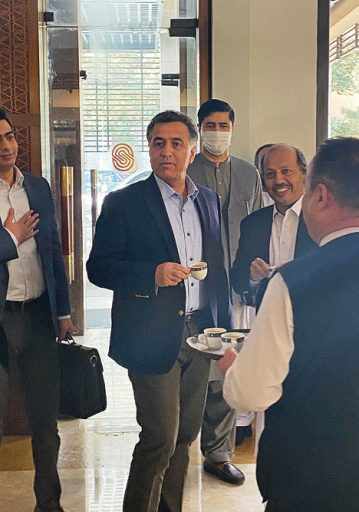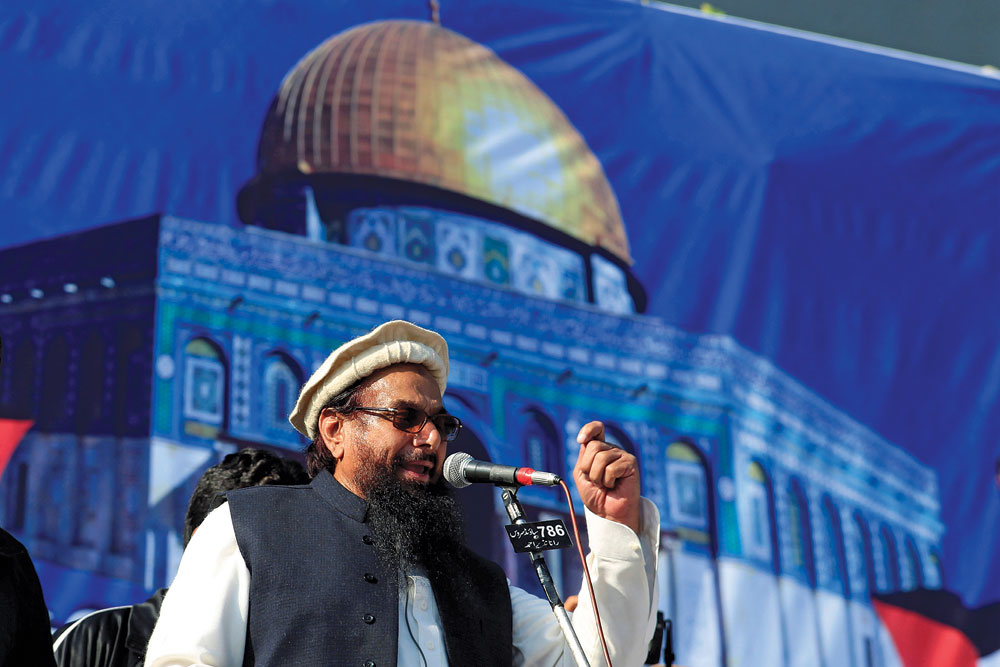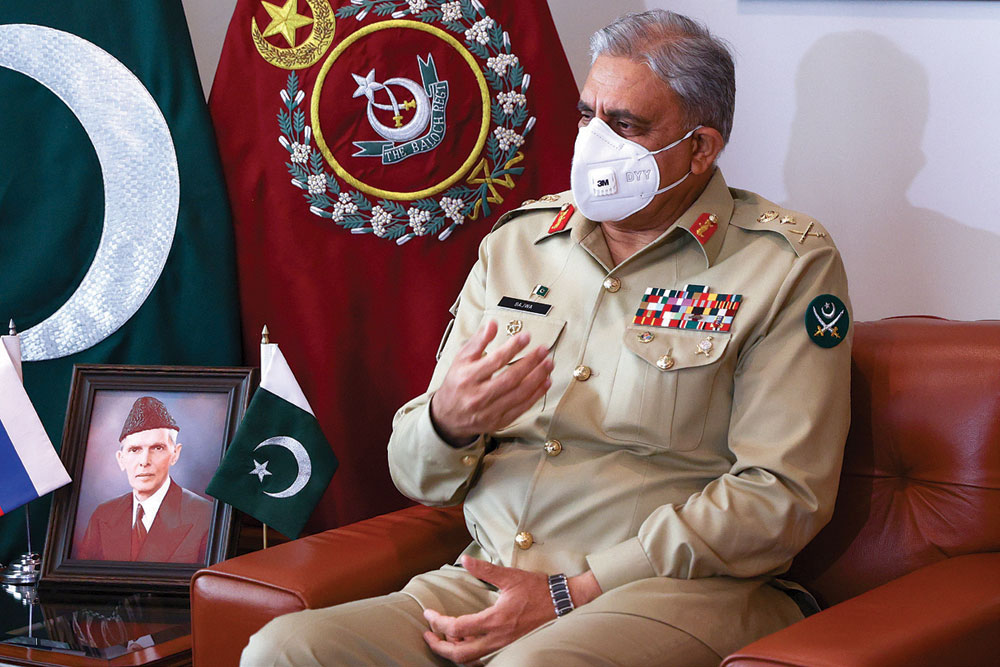Siddharth Singh

SPYMASTERS ARE RARELY seen in public and it is even rarer to see them in a triumphal mood. But on September 4th, Faiz Hameed, the director general of Pakistan’s Inter Services Intelligence (ISI), was seen sipping tea in the lobby of a Kabul hotel and telling a Western journalist “all will be well”. His manner was smug as was that of his country’s Ambassador Mansoor Ahmad Khan.
Four days later, the sinister intent behind those words was for the world to see. The Taliban announced the formation of an interim government to be led by Mullah Mohammad Hassan Akhund, a UN-designated terrorist and the man who was instrumental in the destruction of the Bamiyan Buddhas in March 2001. The ‘good news’ of government formation does not end there: Afghanistan’s new interior minister will be Sirajuddin Haqqani, another terrorist, one with whom India is very familiar. His father—Jalaluddin Haqqani—and his network, of which Sirajuddin is a key member, was responsible for the 2008 bombing of the Indian embassy in Kabul that led to the deaths of 58 people, including India’s Defence Attaché Ravi Datt Mehta, diplomat V Venkateswara Rao and two officers of the Indo Tibetan Border Police (ITBP) who were part of the embassy’s security detail.
It is important to keep in mind these historical events as in the days after the US withdrawal from Afghanistan a ‘debate’ emerged on whether India should engage with a ‘changed’ Taliban, one that had ‘moderated’ its outlook compared to its previous avatar. Events on September 7th put paid to that ‘debate’. The ‘moderate’ faces India was dealing with, representatives of Taliban’s Doha Political Office like Sher Mohammad Abbas Stanikzai, have been sidelined if not totally eliminated from the ruling system. If anything, it is a Pakistani cabinet that is in power in Kabul. For the second time in a quarter century, Pakistan has achieved its cherished goal of finding strategic depth in Afghanistan. Pakistan’s victory on its western front is absolute. It is just a matter of time before Pakistan begins trying to wrest territory on its eastern front, one that it thinks rightly belongs to it.
These developments are deeply disconcerting and pose a threat to India.
The most obvious threat is the use of Afghan territory for terrorist attacks on India. This is a well-known risk. The risk is not just of direct terrorist attacks but also the use of Afghanistan for anti-India activities that cannot be listed in a simple fashion. One example is provided by the hijacking of the Indian Airlines plane to Kandahar in 1999 when it was under Taliban control. The hijacking of the plane was Pakistan-inspired but the aircraft was taken to a third country—Afghanistan—where Pakistan could deny its culpability. With the Taliban back in control, this manner of using Afghan soil against India is a very real threat.
The second risk is even bigger and harder to quantify. Pakistan can now indulge in a ‘military division of labour’ of sorts. With China in a war-like situation against India, a combination of non-state and state actions using China and Afghan proxies is potentially feasible for Pakistan now. It is not as if China will attack India: all it has to do is continue nibbling away at Indian territory, even as terrorists strike in places like Jammu and Kashmir. India does not have to be pinned down in a two-front, regular, war. Irregular tactics are enough to sap its energy. In the past three decades, Pakistan has continuously used the strategy of a thousand cuts but that has not worked. This ‘two-front’ irregular war can do much greater damage.

ISI chief Faiz Hameed in Kabul on September 4
These are external threats but in a noisy democracy like India there are second-order effects from external developments as well. There is now a vigorous debate that India’s constitutional changes in Jammu and Kashmir need to be undone, partially at least, if it is to avoid the worst outcomes from the changed security situation in Afghanistan. Even before the Taliban’s announcement on September 7th, there were calls for India to ensure that mainstream parties in Kashmir get an honourable return to power and statehood is restored. This, it is assumed, will help limit the impact of terrorism emanating from Afghanistan. At the moment, with a strong Government at the helm in New Delhi, it is easy to ignore such calls. But any worsening in the external and internal security conditions will lead to far more vociferous calls for restoring status quo ante in Kashmir, defeating the purpose of constitutional changes there. The combination of external and internal developments is now worth keeping a careful watch on.
The ‘moderate’ faces India was dealing with, such as Sher Mohammad Abbas Stanikzai in Doha, have been sidelined from the ruling system. If anything, it is a Pakistani cabinet that is in power in Kabul
The trouble for India does not lie in Afghanistan, a country where it had only limited political purchase. The real locus of the threat is Pakistan, a country with which India has only had a hallucinated political engagement when what it required was far stronger medicine. Since Independence, India has never cogently thought what needed to be done with its Western neighbour. Part sentimentalism and part half-baked realism have informed India’s attitude towards Pakistan. The events in Afghanistan should—and must—lead to a different perspective.
Since the mid-1980s, about seven to eight years after Zia-ul-Haq gained control of Pakistan, non-state actors were raised, reared and unleashed in Afghanistan. It was a perfect strategy to counter the Soviet threat without provoking conflict. The success of that option made Pakistan ambitious: What if the same strategy could be used against India to prise away Kashmir from its control? Indian mistakes—such as the rigging of elections and its own attempts at forging a pliable political class in Jammu and Kashmir—made matters easy for Pakistan. The rest is history: terrorism metastasised into military conflict and the chance for peace has all but disappeared.
IS THERE A practical lesson one could learn from this part of Pakistan’s history, one that would help us understand the country better and devise an appropriate strategy to counter it?
This aspect of Pakistan’s history is intriguing for its resonance with a truism that goes back to Socrates: regime types matter in how a country behaves with other countries. A democracy is unlikely to engage in and export terrorism; a tyrannical regime is more likely than any other kind of regime—say, democracy or aristocracy—to export terrorism or indulge in wars. In Pakistan, this trend, dating to the Zia years, is worth contrasting with an earlier time when it was democratic. Historian Pallavi Raghavan notes in her book Animosity at Bay that, in the initial years after Independence, there was a great measure of cooperation between the two countries on a number of bilateral issues.
 Hafiz Saeed, co-founder of Lashkar-e-Toiba, at a protest in Rawalpindi, December 19, 2017 (Photo: Reuters)
Hafiz Saeed, co-founder of Lashkar-e-Toiba, at a protest in Rawalpindi, December 19, 2017 (Photo: Reuters)But once Zia mobilised religion, seminaries and their personnel, there was no looking back. It is not a coincidence that ever since his time, Pakistan has never been a functional democracy. There are prime ministers but they hardly control policymaking on India. This has continued till today.
Indians have learnt two very different lessons from Pakistan’s history. There are those who believe that democracy and cultivating a constituency in Pakistan will go a long way in ending terrorism and resolving disputes. This tradition has gone so far as to say that “rendering borders meaningless while not changing them” is the way forward for India.
Pakistan can now indulge in a ‘military division of labour’. Eith Vhina in a war-like situation against zindia, a combination of non-state and state actions using China and Afghan proxies is feasible for Pakistan now
The other interpretation, favoured by a minority in India, is that a regime type is not just a change in the personnel who man a state: regimes, to quote Francis Fukuyama, “are not just formal institutions and authority structures; they shape and are shaped by societies underlying them. The unwritten rules by which people operate, based on religion, kinship and shared historical experience, are also a part of the regime.” From this vantage, it does not matter who rules Pakistan, the changes that were set in motion in the mid-1980s have taken it so far away from democracy that its internal structure is now menacing for India and its other neighbours.
This, however, is an interpretation not favoured by the Indian elite. For various contingent and historical reasons, India’s foreign policy elite, its intellectuals and liberal commentators now routinely doubt their country’s legitimacy in ‘holding’ Jammu and Kashmir. Some openly call for a ‘sharing’ arrangement with Pakistan over the erstwhile state; others simply declare India to be in illegitimate occupation.
The result is India’s inability to do anything meaningful to check terrorism emanating from Pakistan. Until some years ago, India did not even bother to break diplomatic relations when Pakistan unleashed mayhem in Mumbai. Military options were not considered infeasible; they were actively disliked. This attitude ensured that talks with Pakistan went nowhere. That country held on to its maximalist position that India should, one way or another, give up Jammu and Kashmir. Only then would there be some movement towards normalcy. An impasse of sorts emerged. The political elite in India wanted to continue talking to Pakistan but hoped that it would not use terrorism as an instrument to get what it wanted. Terrorism continued and talks degenerated into ‘talks about talks’.
IF NEGOTIATIONS AND normal behaviour are not possible, what are India’s options against Pakistan? The question is important in the context of Afghanistan as Pakistan will be tempted to use terrorism to extract what it wants from India.
After February 2019, there has been no major terrorist strike in India by Pakistani-origin terrorists. There are sporadic incidents in Jammu and Kashmir but those are in the nature of an on-going insurgency and are far below the threshold that India would deem acceptable. Statistically, the peak of the insurgency in Kashmir lies in the past. India responded to the attack on a military facility in Uri with a “surgical strike” in Pakistan-Occupied Kashmir (PoK) in September 2016 and to the February 2019 Pulwama attack by striking in Balakot, Khyber Pakhtunkhwa. Both were in the nature of calling Pakistan’s bluff that any military option exercised by India in response to a terrorist incident would lead to an immediate escalation to the nuclear level.
 Pakistan’s Chief of Army Staff General Qamar Javed Bajwa at a meeting in Islamabad on April 7 (Photo: Getty Images)
Pakistan’s Chief of Army Staff General Qamar Javed Bajwa at a meeting in Islamabad on April 7 (Photo: Getty Images)The Indian responses were described by Western political analysts as dangerous escalations. The wording is worth noting: India’s right to respond is held to be an escalation while Pakistani behaviour is expected to have no consequences. This is not just a language issue but a psychological one as well. India’s response in both cases was held to be a dangerous futility as in the next round of Pakistani terrorist behaviour India would have to escalate further. The possibility of the ladder running out and reaching the nuclear level was held as an ever-present possibility. Again, these analysts did not pause and ask why Pakistan does not have the same fear of escalation getting out of control and why only India has to fear that possibility. Militarily and analytically, these asymmetries are held to work only to India’s disadvantage. No one stopped to think if this was a line of behaviour and reasoning that was quite out of line with reality.
In analytical terms it is hard to claim success for India’s ‘bold policy’ in keeping Pakistan at bay. But in practical terms, Delhi may have found an option to escape the so-called nuclear overhang and failure of deterrence against Pakistan
In analytical terms it is hard to claim success for India’s ‘bold policy’ in keeping Pakistan at bay. But in practical terms, the country may have found an option to escape the so-called nuclear overhang and failure of deterrence against Pakistan. Its success is primarily due to a leadership willing to call out an incredible threat. Its credibility lies in not letting the enemy anticipate its moves. Credible signals always carry a cost. In India’s case, the potential cost includes escalation and the willingness to bear the costs associated with it. These can include a widening of military conflict. But this is not a one-sided cost: Pakistan, too, has to face costs and in its case, those can be much more painful. India can always keep a list of targets ready to strike. Further, Pakistan’s bluff on the so-called space threshold—a nuclear response to India nibbling away at its territory—too, can be called. For example, in any widening of military conflict, India should be prepared to chew off parts of territory that belong to it but are under Pakistani control. Haji Pir Pass in PoK is one such piece of land. The danger of internal political upheaval in an undemocratic regime where political parties and the army are in conflict with each other is much higher. This is a recipe that India should include in its set of options against Pakistan.
Military responses to Pakistan cannot be described as a strategy; they are merely a device to keep that country at bay. A proper strategy requires much more in intellectual terms, something India is incapable of, at least for now. Until India acquires what is necessary, or until Pakistan realises the futility of its choices, “keeping the enemy at bay” has to be a substitute for strategy. It has worked in the recent past and can work in future as well.
No comments:
Post a Comment